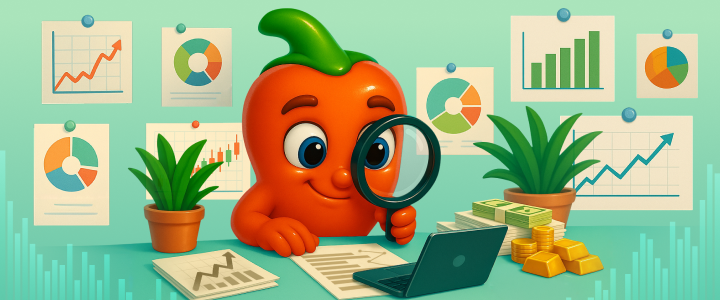How risk management is structured in prop firm
19.06.2025
Formazione
The main asset of prop trading firms is capital. With the help of talented traders, prop company owners want to increase it. The faster - the better. But in pursuit of profit, professionals always remember the primary task - not to lose what they already have.

Finding a balance is not easy. There is no magic cure. Prop trading firms have to use all available tools. From them, they build multi-level protection systems. Each layer neutralizes its risks.
At the stage of selecting traders through a challenge, companies choose discipline and a stable result. The risk management department of the prop company automatically monitors the trading of those who have passed the exam. Finally, the system of distribution of funds encourages marathon traders. The longer the trading distance, the more the account is scaled. Let's consider all this in more detail.
Challenge is the first level of protection. No matter how talented a trader is, but if he does not know how to control risk, he will not be able to become part of a prop trading team. Engineers have a good expression: the reliability of a system is determined by the strength of its weakest link.
There can be no exceptions. From a rock star with periodic takeoffs of thousands of percent per annum and a systematic worker with 5.0% profit from month to month, the prop company will choose the latter. And will gradually increase the amount of funds under his management.
You can load up to $20 million on 10 "workers" without a noticeable effect on their psychology. For 100 such traders up to $200 million. Usually prop companies do not go beyond these limits. Administering such a scale of trade is no longer an easy task. Therefore, there are no concessions on challenges.
A trader must be able to adjust a trading strategy. If a challenge sets a limit on daily losses of 5.0%, and on total losses of 11.0%, then under no circumstances can they be exceeded. If the conditions change, adjustments are made again. Only those who can do this will get to the next level.
At the next level of protection, when prop company funds can already be involved in trading, an automated system of restrictions comes into play. Depending on the conditions of the funded account: the amount, the volume of positions, the parameters of acceptable losses, it monitors the risks. And if the limit is exceeded, it acts automatically. Closes the position. Blocks trading until the next day. Or performs other actions. The work of the automation is monitored by specialists of the risk management department.
Another level of protection is the trader's reward. It is not limited to the distribution of earned profits. The trader's share can reach 90%. Everything is clear here. The direct benefit of the prop trader depends on the profitability of trading.
But a much more valuable protection tool is the account scaling system. For example, if a prop trader shows a profit of 10.0% or more for 2 months in a row, the funds available for trading increase by 40.0%. It is profitable for the trader to trade stably.
After 6 months with an average yield of 5.0% per month, he will receive an increase in the amount under management by 174%. After 12 months, by 651%. The smoother the trading, the more company funds will go to this trader for management. Scaling has its own safe limit. Usually it is $1,000,000-2,000,000.

Prop firms need to find a balance between the two opposites of Yin and Yang. Maintaining the harmony of the correct settings in the risk management system. This is the key to the success of prop companies. Capital grows so quickly that it does not threaten its safety.
Finding a balance is not easy. There is no magic cure. Prop trading firms have to use all available tools. From them, they build multi-level protection systems. Each layer neutralizes its risks.
At the stage of selecting traders through a challenge, companies choose discipline and a stable result. The risk management department of the prop company automatically monitors the trading of those who have passed the exam. Finally, the system of distribution of funds encourages marathon traders. The longer the trading distance, the more the account is scaled. Let's consider all this in more detail.
1. Challenge
Challenge is the first level of protection. No matter how talented a trader is, but if he does not know how to control risk, he will not be able to become part of a prop trading team. Engineers have a good expression: the reliability of a system is determined by the strength of its weakest link.
There can be no exceptions. From a rock star with periodic takeoffs of thousands of percent per annum and a systematic worker with 5.0% profit from month to month, the prop company will choose the latter. And will gradually increase the amount of funds under his management.
You can load up to $20 million on 10 "workers" without a noticeable effect on their psychology. For 100 such traders up to $200 million. Usually prop companies do not go beyond these limits. Administering such a scale of trade is no longer an easy task. Therefore, there are no concessions on challenges.
A trader must be able to adjust a trading strategy. If a challenge sets a limit on daily losses of 5.0%, and on total losses of 11.0%, then under no circumstances can they be exceeded. If the conditions change, adjustments are made again. Only those who can do this will get to the next level.
2. Automatic restrictions
At the next level of protection, when prop company funds can already be involved in trading, an automated system of restrictions comes into play. Depending on the conditions of the funded account: the amount, the volume of positions, the parameters of acceptable losses, it monitors the risks. And if the limit is exceeded, it acts automatically. Closes the position. Blocks trading until the next day. Or performs other actions. The work of the automation is monitored by specialists of the risk management department.
3. Protection through distribution of funds
Another level of protection is the trader's reward. It is not limited to the distribution of earned profits. The trader's share can reach 90%. Everything is clear here. The direct benefit of the prop trader depends on the profitability of trading.
But a much more valuable protection tool is the account scaling system. For example, if a prop trader shows a profit of 10.0% or more for 2 months in a row, the funds available for trading increase by 40.0%. It is profitable for the trader to trade stably.
After 6 months with an average yield of 5.0% per month, he will receive an increase in the amount under management by 174%. After 12 months, by 651%. The smoother the trading, the more company funds will go to this trader for management. Scaling has its own safe limit. Usually it is $1,000,000-2,000,000.
Popular articles
Notizie
Feedbacks
Notizie
Notizie
Notizie
Service Update: Temporary Technical Issues
25.09.2025
Notizie
Notizie
Notizie
Notizie
Notizie
Notizie
Notizie
Notizie
Feedbacks
Notizie
Notizie
Notizie
Notizie
Feedbacks
Feedbacks
Notizie
Notizie
Feedbacks
Notizie
Feedbacks
Notizie
Notizie
Feedbacks
Feedbacks
Notizie
Notizie
Notizie
Notizie
Feedbacks
Notizie
Feedbacks
Feedbacks
Notizie
Feedbacks
Notizie
Ottieni doppi reset e conti extra gratis!
14.03.2025
Feedbacks
Notizie
Feedbacks
Notizie
Feedbacks
Feedbacks
Feedbacks
Notizie
Festeggia il capodanno cinese con SpiceProp
05.02.2025
Notizie
Notizie
Notizie
Feedbacks
Feedbacks
Notizie
Notizie
Notizie
Notizie
Notizie
Feedbacks
Notizie
Notizie
Notizie
Feedbacks
Feedbacks
Notizie
Notizie
Notizie
Notizie
Notizie
Feedbacks
Colloquio
Feedbacks
Notizie
Notizie
Feedbacks
Colloquio
Feedbacks
Notizie
Notizie
Notizie
Notizie
Notizie
Feedbacks
Notizie
Feedbacks
Notizie
Notizie
Colloquio
SpiceProp a Invest Cuffs 2024. TV Aziendale
04.05.2024
